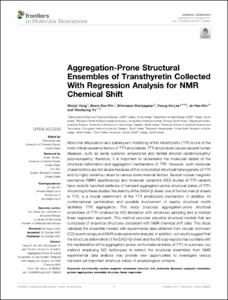Aggregation-Prone Structural Ensembles of Transthyretin Collected With Regression Analysis for NMR Chemical Shift
- Title
- Aggregation-Prone Structural Ensembles of Transthyretin Collected With Regression Analysis for NMR Chemical Shift
- Author(s)
- Yang, Wonjin ; Kim, Beom Soo ; Muniyappan, Srinivasan ; Lee, Young-Ho ; Kim, Jin Hae ; Yu, Wookyung
- Issued Date
- 2021-10
- Citation
- Frontiers in Molecular Biosciences, v.8
- Type
- Article
- Author Keywords
- molecular dynamics computer simulation ; protein aggregation ; ensemble structure ; linear regression ; transthyretin ; nuclear magnetic resonance chemical shift
- Keywords
- MOLECULAR-DYNAMICS ; PROTEIN-STRUCTURE ; PRE-ALBUMIN ; SECONDARY ; PREDICTION ; ACCURATE ; DISEASE ; CONFORMATIONS ; RECOGNITION ; FIBRILS
- ISSN
- 2296-889X
- Abstract
- Monomer dissociation and subsequent misfolding of the transthyretin (TTR) is one of the most critical causative factors of TTR amyloidosis. TTR amyloidosis causes several human diseases, such as senile systemic amyloidosis and familial amyloid cardiomyopathy/polyneuropathy; therefore, it is important to understand the molecular details of the structural deformation and aggregation mechanisms of TTR. However, such molecular characteristics are still elusive because of the complicated structural heterogeneity of TTR and its highly sensitive nature to various environmental factors. Several nuclear magnetic resonance (NMR) spectroscopy and molecular dynamics (MD) studies of TTR variants have recently reported evidence of transient aggregation-prone structural states of TTR. According to these studies, the stability of the DAGH β-sheet, one of the two main β-sheets in TTR, is a crucial determinant of the TTR amyloidosis mechanism. In addition, its conformational perturbation and possible involvement of nearby structural motifs facilitates TTR aggregation. This study proposes aggregation-prone structural ensembles of TTR obtained by MD simulation with enhanced sampling and a multiple linear regression approach. This method provides plausible structural models that are composed of ensemble structures consistent with NMR chemical shift data. This study validated the ensemble models with experimental data obtained from circular dichroism (CD) spectroscopy and NMR order parameter analysis. In addition, our results suggest that the structural deformation of the DAGH β-sheet and the AB loop regions may correlate with the manifestation of the aggregation-prone conformational states of TTR. In summary, our method employing MD techniques to extend the structural ensembles from NMR experimental data analysis may provide new opportunities to investigate various transient yet important structural states of amyloidogenic proteins. Copyright © 2021 Yang, Kim, Muniyappan, Lee, Kim and Yu.
- Publisher
- Frontiers Media S.A.
- Related Researcher
-
-
Kim, Jin Hae
- Research Interests
-
- Files in This Item:
-
 기타 데이터 / 3.25 MB / Adobe PDF
download
기타 데이터 / 3.25 MB / Adobe PDF
download



